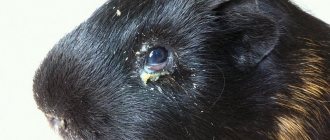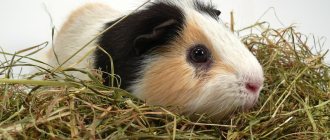Even with good care, by the age of five, guinea pigs begin to develop pathological processes that lead to the death of the animals. Genetics are a common cause of tumors in guinea pigs. If a tumor is detected in a guinea pig, it is necessary to exclude the development of a purulent abscess, which can develop from a bruise, pricks from branches or sawdust. In any case, if any lump appears, you should call a veterinarian.
Treatment of tumors in guinea pigs
Even with good care, by the age of five, guinea pigs begin to develop pathological processes that lead to the death of the animals. Genetics are a common cause of tumors in guinea pigs. If a tumor is detected in a guinea pig, it is necessary to exclude the development of a purulent abscess, which can develop from a bruise, pricks from branches or sawdust. In any case, if any lump appears, you should call a veterinarian.
Tumors can form from any tissue on any organ: from the skin and mucous membranes, from internal parenchymal organs, from tissues containing glands, from bone and cartilage tissue, from fat and muscle. Tumors are named according to the tissue from which they are formed.
The cause of the abscess and its symptoms
An abscess is an inflammatory lesion in which pus accumulates. It is formed due to the penetration of infection and the proliferation of pathogenic microorganisms. This is a dangerous disease, and as it develops and spreads, death cannot be ruled out.
In some cases, the animal’s body copes with the inflammatory process itself, the pus comes out, and the wound heals. But if the focus is deep, infection provocateurs multiply quickly, the abscess progresses rapidly, and urgent treatment is necessary.
The causes of infection may be damage to the skin by hay or a bite from another animal. If the wound is not treated, microbes and bacteria penetrate into it, causing inflammatory processes. Externally, the disease manifests itself by the formation of a lump. Its location is determined by the cause of the inflammatory focus:
- When two animals are kept in the same cage, fights can occur between the pets. As a result of bites, infectious abscesses appear on the back and back.
- In the process of eating hay, microtraumas can occur. They cause tumors in the head area.
- In the case of molars growing into the bone, a periapical formation occurs in the jaw area.
If the formation is small, you can try to treat the abscess at home. It is necessary to initiate the process of the pus coming out, for which an iodine mesh is made on the tumor, compresses with Vishnevsky ointment are applied. In most cases, surgery is required to treat abscesses. In addition, the tumor can appear in other diseases. Therefore, it is better to contact a veterinary hospital.
There are several stages in the development of the disease:
- the appearance of swelling in the affected area;
- tumor growth, pain during mechanical action;
- the appearance of an opening for the release of pus.
A note for the caring guinea pig owner. Guinea pig diseases
Hold your pet daily
. This is not only very pleasant, but also useful, because with close contact you get a unique opportunity to carefully examine your ward for all kinds of diseases. And the regular stroking that the pig receives from you has the best effect on the condition of its fur, which is thus renewed and a new one immediately grows in place of the old one.
Every day carefully
inspect the animal's fur and eyes for clouding of the lens. Let's evaluate the character of the animal. He should be calm and affectionate, although each pig may have its own individual character traits. The main thing is that your favorite creature is not aggressive. If you notice any abnormalities, contact your veterinarian or veterinarian as soon as possible, even if it seems like a minor thing. But later this can develop into a fairly serious problem that will require long and lengthy treatment.
Now there is no longer any need to look for a veterinary clinic, because you are on our website and reading this article. Here at any time you can get qualified advice from professional doctors “YA-VET”, who are always ready to help.
Which veterinary clinic to choose for treatment of guinea pig disease
In order for your beloved guinea pig to recover, it is necessary to find a qualified specialist as soon as possible who can make the correct diagnosis and prescribe adequate treatment. After all, a correct diagnosis of guinea pig disease is already half the success. Further responsibility lies entirely with the owner - the health of the rodent depends only on him. You will need to carefully follow all doctor's instructions
, such as following a diet, giving the necessary medications on time, which will help you recover faster.
You will also need to take care of the proper maintenance of the guinea pig. It is unacceptable to place the cage in drafts. The pet may be blown away. It is also recommended that during the recovery period, the greatest attention be paid to the cleanliness of the cage in which the pet lives. This also plays an important role in recovery, because these harmful microorganisms are also present in urine and feces, which can then come back.
The specialists of our veterinary clinic “YA-VET” have the necessary education, which allows them to provide comprehensive assistance. Remember that guinea pigs are a blessing that nature itself gave us and should be cherished like the apple of our eye. For all their charm, these pets are quite gentle and need to be protected from any diseases that a difficult life can give.
Treatment of abscesses
The main technique for an abscess is resection of diseased tissue and disinfection. It is performed under general anesthesia. After it, for complete recovery and to exclude relapse, the following are prescribed:
- treatment of surgical sutures within 2 weeks;
- antibiotic injections for a week;
- washing the abscess capsule if it remains after surgery.
Periapical abscesses are particularly difficult, as they prevent the pet from eating. After their removal, the following are added to the main treatment regimen:
- anesthetics;
- forced feeding;
- course of corticosteroids.
If there are complications, infusion therapy is prescribed.
Main diseases by organs and systems
Note that age-related pathologies are rare for guinea pigs. It is better to consider diseases of specific organs and systems, since they can affect animals at any age.
Eye diseases
Eye diseases in pigs are not very diverse:
- Conjunctivitis, i.e. inflammation of the mucous membrane of the eye.
- Keratitis and glaucoma.
- In very rare cases - ulcerative lesions of the cornea.
The symptoms are as follows:
- The animal often suffers from photophobia, squints and moves away from any light source.
- The eyes are squinted and the eyelids may swell. Because of this, the pig almost never opens its eyes completely.
- Exudate constantly oozes from the eyes (it can be liquid, purulent or any other).
Dental diseases
- Poor bite due to overgrown incisors. Rodents' incisors grow constantly. If they do not wear off on hard food, the animal resembles a saber-toothed tiger. In these same cases, teeth can break off.
- Tooth loss. This is only possible if you have an extremely unbalanced diet.
- Caries, abscesses, pulpitis and other inflammatory pathologies.
- Dental cheilitis , i.e. fungal infection of teeth.
Various types of tumors, their localization
Guinea pigs over the age of five years are at risk for cancer. Malignant tumors in these animals are diagnosed quite often. The appearance of neoplasms is provoked by various reasons. This may be a hereditary predisposition, stress, obesity. The appearance of a tumor can be caused by food containing chemical dyes and preservatives. They can occur on mucous membranes, organ tissues, and bones.
A benign tumor, unlike a cancerous one, does not spread throughout the body. These tumors are dangerous because as they grow, they put pressure on neighboring organs and disrupt their functions. Large tumors can completely immobilize the animal. These formations are easily cured by surgical removal.
A malignant tumor not only grows, but also forms metastases that penetrate healthy tissue. If such a disease is diagnosed, euthanasia is recommended, since cancer cannot be completely cured. You don’t have to kill your pet, just let it live out its term. In this case, the guinea pig needs to be provided with quality care, good nutrition and painkillers.
Most neoplasms in pets appear in the following areas:
Types of neoplasms and localization
Benign and malignant tumors in guinea pigs can appear on any part of the body, and can also be localized in internal organs. More often they occur due to genetic factors. But their growth can be triggered or accelerated by injuries, stress, a sharp decrease in immunity and feeding with foods that contain synthetic dyes, trans fats, preservatives and flavors.
Mammary gland
Tumors of the mammary glands occur in both females and males almost equally. Rodents over 4–5 years of age are susceptible to this disease.
In most cases, these neoplasms are benign. First, a small bump appears on the stomach, which slowly increases in size, but does not cause discomfort or anxiety to the rodent. However, if left untreated, there is a risk of its malignant degeneration or compression of adjacent organs, large blood vessels and nerve endings.
Signs of a malignant mammary tumor in guinea pigs are the rapid development of swelling, and subsequently the formation of abscesses, which, after opening, form fistulas.
Important! If breast cancer has reached the stage of abscesses and fistulas, veterinarians give an unfavorable prognosis and offer euthanasia to save the pet from suffering.
Neck
The cause of a lump on a guinea pig's neck may be:
- abscess;
- enlargement of the thyroid gland;
- inflammation of the lymph nodes;
- development of lymphosarcoma.
To make an accurate diagnosis, you need to contact a veterinary clinic, where competent treatment will be prescribed and carried out.
Important! Soon after the enlargement of the lymph nodes in the neck, pathological proliferation of their tissues in the groin and armpits is observed. This indicates the development of metastases and the involvement of other internal organs in the process.
Back and sides
The appearance of a lump on the back of a guinea pig may indicate the development of either a lipoma or a malignant tumor. When a neoplasm is first detected, you should contact the clinic to determine its nature and carry out treatment.
If a guinea pig has a lump on its side, it most often indicates cancer of the lungs, kidneys, liver, spleen or other abdominal organs.
Symptoms that prove the tumor is malignant:
- inactivity;
- apathy;
- loss of appetite or complete refusal of food;
- loose stools;
- the appearance of blood in stool and urine;
- urinary retention.
For this type of cancer, surgery is ineffective, so a veterinarian may recommend euthanasia.
Leather
Basal cell skin cancer is a common finding in guinea pigs. First, oval-shaped bumps appear in the area of the hind legs, which, without proper treatment, quickly turn into weeping wounds. After the penetration of pathogenic microflora, they begin to fester, the tissues underneath melt and acquire an unpleasant odor.
If such a tumor is removed before a wound appears, then doctors give a favorable prognosis.
Important! Basal cell carcinoma is a genetically determined pathology that is inherited. Therefore, such guinea pigs are rejected from breeding.
Cheeks
Bumps on the cheeks may indicate dental disease, abscesses in the oral cavity, as well as the development of malignant and benign tumors.
Tumors have a dense structure, make chewing food difficult, and negatively affect appetite.
The examination can only be carried out in a clinic, as reliable fixation, local anesthesia and special medical instruments are required.
Mammary gland
Older female and male guinea pigs have a serious risk of developing a tumor in the mammary glands. Most often these are benign tumors. When pathology appears in the lower abdomen, a lump appears that is not connected to the subcutaneous tissue and has a dense structure.
A malignant tumor differs from a benign one:
- swelling;
- formation of infectious foci, abscess;
- connection with subcutaneous tissue.
For whom is this article “Diseases of Guinea Pigs”
This article was created both for future guinea pig owners and for experienced owners who want to learn more about their cute pets and how to treat them in case of illness. All advice is advisory in nature
, and therefore the best solution would be
to show the pig to a ratologist in Moscow in the very near future.
Every day of delay can cost your guinea pig's health. All people, without exception, love to play with these fluffy, charming creatures. Learning to monitor their health is also not difficult. It is enough to know the basic signs, and then the disease in guinea pigs will not have a chance to take possession of your pet.
Back and sides
Swellings on the sides and back appear when a tumor forms on an internal organ. In most cases these are oncological diseases. A lump may appear on the side if the liver, kidney, spleen, intestines, or lung are affected by a malignant tumor.
In addition to the formation of a tumor, in the presence of malignant neoplasms, the animal experiences the following symptoms:
- loss of appetite;
- lethargy, apathy;
- discharge of blood from the mouth, its appearance in urine and feces.











